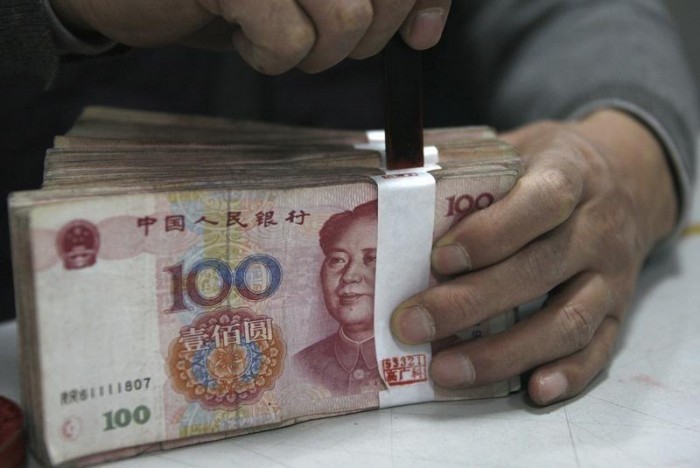
Wall Street Journal reports that The calm in China's currency is making some investors uneasy. Twice in the past year, sudden drops in the value of the yuan have rattled global markets, sparking concerns that a deeper decline was at hand as officials struggle to orchestrate an economic "soft landing" following years of debt-fueled growth. Since then, the People's Bank of China has calmed the waters by improving communications and the government has increased stimulus in a bid to stabilize growth. The Federal Reserve's decision to delay rate increases has kept a lid on the value of the U.S. dollar, relieving some of the pressure on the yuan. Yet in a refrain familiar by now to investors the world over, analysts are worrying that stimulus alone won't be enough to get China's growth back on track and support the yuan indefinitely. Fundamental indicators of Chinese economic health continue to deteriorate, a sign to skeptics that the currency remains overvalued and a reminder of the challenges facing the world's second-largest economy. "China has done a good job in anchoring market expectations and using all the tools in its policy toolbox to stabilize the economy, but it hasn't fixed the underlying problems," said David Loevinger, a managing director at TCW Group, which has $194.6 billion of assets under management.
- Reuters reports that Profits earned by China's industrial firms grew at their fastest pace in four months in July, aided by a pick-up in sales and reduced costs, the statistics bureau said on Saturday. Profits in July rose 11.0 percent to 523.01 billion yuan, the National Bureau of Statistics (NBS) said, the fastest growth rate since March. "Although the growth in industrial profits has accelerated, we still haven't seen an obvious pick up in demand in the market," NBS official He Ping said in a statement accompanying the data. He said challenges posed to strong industrial profit growth include rising management costs and the costs of tackling overcapacity.
- PRI reports Throughout its 100-year history, US National Parks have served as a model for other countries trying to set up their own networks of protected spaces. Now China is quietly planning its own national parks system And, like Costa Rica and India before them, the Chinese are looking toward America. "They've visited several locations in the US, and they're basically trying to get ideas on how US parks are managed," said Beijing-based science journalist Kathleen McLaughlin. About two dozen national parks are planned, ranging in size from small urban parks like the National Mall in Washington, DC, to a park in northeastern China more than twice the size of Yellowstone aimed at protecting Siberian tigers and leopards.
- 2016-08-26 They built towering new cities in China. Now they're trying it in downtown L.A.
- 2016-08-25 The New Face of Chinese Nationalism
- 2016-08-24 The Morning Risk Report: Uneven Enforcement Worries U.S. Firms in China
- 2016-08-23 UN envoy: China must give public voice to stamp out poverty
- 2016-08-22 China slams U.S.-South Korea military drills even as it stages naval war games of its own
- 2016-08-21 Chhines Ships, Planes Hold War Games in Sea of Japan
- 2016-08-19 Rio 2016: China Rethinks Gold Medal Pursuit at Olympics
- 2016-08-18 China’s Pollution Deaths to Linger After Air Clears, Study Finds
- 2016-08-17 China, ASEAN aim to complete framework of South China Sea rules next year
- 2016-08-16 UK’s May reassures China after nuclear power plant delay
- Bloomberg No Need to Be Alarmed by China Private Investment Crash, Say Analysts
- Bloomberg China's Murky World Where E-Commerce Meets Student Lending
- Bloomberg China Stock Traders Feel the Heat With 774 Probes in Two Months
- Forbes China And Pakistan Beware -- This Week, India And US Sign Major War Pact
- Wall Street Journal China Establishes New State-Owned Aircraft-Engine Maker
- Reuters China names new chief for Tibet in party reshuffle
- Reuters Lazy officials criticized as China launches inspection to ensure growth on...
- The Guardian China: the new space superpower
- Reuters China to rein in aggressive acquisitions by insurers - Caixin
- New York Times China Says School Condemned in TV Pollution Report Is Safe
- The Telegraph China's pushy parents enrolling their toddlers in 'CEO courses'
- The Diplomat Four Considerations on the Chinese Economy
- Forbes India's Grand Gamble With China
- Reuters As Obama heads to Laos, signs of a tilt away from China
- nationalinterest.org US Military's Worst Nightmare: A War with Russia and China (at the Same Time)
- foreignpolicy.com China Is Fueling a Submarine Arms Race in the Asia-Pacific
- The Diplomat The G20 Summit: An Opportunity for India-China Relations
- Fortune China's Richest Man Has a New $9 Billion Plan to Crush Disney
- The Diplomat A New Legal Landscape in the South China Sea
